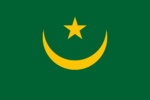Knowledge fuels change - Support energypedia!
For over 10 years, energypedia has been connecting energy experts around the world — helping them share knowledge, learn from each other, and accelerate the global energy transition.
Today, we ask for your support to keep this platform free and accessible to all.
Even a small contribution makes a big difference! If just 10–20% of our 60,000+ monthly visitors donated the equivalent of a cup of coffee — €5 — Energypedia would be fully funded for a whole year.
Is the knowledge you’ve gained through Energypedia this year worth €5 or more?
Your donation keeps the platform running, helps us create new knowledge products, and contributes directly to achieving SDG 7.
Thank you for your support, your donation, big or small, truly matters!
Mauritania Energy Situation
| Islamic Republic of Mauritania | |||
|
Capital |
Nouakchott (18°09′N 15°58′W) | ||
|
Official language(s) |
Arabic | ||
|
Government |
Islamic republic | ||
|
President |
Mohamed Ould Abdel Aziz | ||
|
Prime Minister |
Moulaye Ould Mohamed Laghdaf | ||
|
Total area |
1,030,700 km2 | ||
|
Population |
3,291,000 (2009 estimate) | ||
|
GDP (nominal) |
$3.029 billion | ||
|
GDP Per capita |
$975 | ||
|
Currency |
Ouguiya (MRO) | ||
|
Time zone |
CET (UTC+00) | ||
|
Calling code |
+222 | ||
Overview
Mauritania was originally a nomad country, which for the last 50 years has evolved into a settled one. 65% of the population was nomad in 1965 compared to the 95% that has been settled in 2001. An urbanization process has been in place since the 70’s and the urbanization rate doubled between 1970 (22,7%) and 2000 (50%). Currently, the population growth is around 2,6% per year. All these transformations in Mauritania are affecting the energy consumption necessitating an evolution in the energy supply. Mauritania is mostly dependent on non-renewable resources (fossil fuels) and the access rate to the grid is pretty low. Some projects are emerging to benefit from solar, wind and biomass resources and to increase the access rate to the grid.
Energy Sources
Hydropower
There isn’t much of a hydropower potential in Mauritania. Nevertheless, the country imports hydropower electricity from Manantali hydropower plant[1]. This source can provide 30 MW to Mauritania, mostly for the cities of Boghé and Kaédi. Mauritania aims to increase the share of hydropower electricity to 30% by 2015. To do that, it will add to Manantali, the imported electricity from Felou (20 MW)[2] and Gouina[3] (40 MW) hydropower plants.[4]
[1] Le barrage de Manantali - OMVS internet site http://www.portail-omvs.org/infrastructure-regionale/barrages/barrage-manantali
[2] Aménagement Hydroélectrique de Félou European Bank of Investment internet site http://www.eib.org/projects/pipeline/2003/20030347.htm
[3] Projets de barrages – OMVS internet site http://demo.portail-omvs.org/infrastructure-regionale/barrages/projets-barrages
[4] Financement d’une centrale hybride photovoltaïque/thermique à Kiffa et des réseaux électriques de la région de Kiffa – AFD – (2012)
Solar Energy
Biomass
In 2012, a project co-financed by European Union and GIZ was established to promote improved cookstoves in the rural and semi-urban areas of Guidimakha[1]. This project aims to promote 5 000 improved cookstoves (ICS) through the following:
· Organizing media and proximity campaigns to promote ICS
· Sensitizing and training users to apply good practices of utilization
· Training producers of ICS in the production and marketing techniques and in SME management
· Supporting the introduction, implementation and marketing of ICS
· Supporting professional training and capacity development centers to add cleaner cooking stove production to their training programs.
Biogas
Wind Energy
Recently, the National Assembly adopted a law that allows the acceptance of a FADES loan to construct a 30MW wind power plant[1].
SNIM has also developed a 4 MW wind power plant in Nouadhibou that has been paid for with their own resources[2].
[1] Adoption du projet de loi 239/13 et 240/13 - National Assembly internet site http://assembleenationale-mr.org/index.php?option=com_content&view=article&id=483:-adoption-du-projet-de-loi-23913-et-24013&catid=3:newsflash&lang=en
[2] Inauguration de la centrale éolienne de la SNIM - SNIM internet site http://www.snim.com/index.php/news-a-media/news/10-inauguration-de-la-centrale-eolienne-de-la-snim.html
Geothermal Energy
Fossil Fuels
Key Problems of the Energy Sector
Policy Framework, Laws and Regulations
General Energy Policy, Energy Strategy
Important Laws and Regulations
Specific Strategies
In 2012, Mauritania’s Prime Minister adopted an environmental national action plan (PANE 2) for 2012-2016. This action plan was developed by Ministère délégué auprès du Premier Ministre en charge de l’Environnement et du Développement Durable to especially include a wood energy strategy. This strategy covers the wood energy value chain (production, exploitation, distribution, and consumption) [1]
Institutional Set-up in the Energy Sector
Activities of Donors and Implementing Agencies
Further Information




















